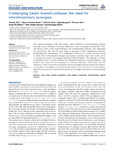Mostrar o rexistro simple do ítem
Challenging Easter Island’s Collapse: The Need for Interdisciplinary Synergies
| dc.contributor.author | Rull, V. | |
| dc.contributor.author | Cañellas-Boltà, Núria | |
| dc.contributor.author | Sáez, Alberto | |
| dc.contributor.author | Margalef, Olga | |
| dc.contributor.author | Bao, Roberto | |
| dc.contributor.author | Pla-Rábes, Sergi | |
| dc.contributor.author | Valero Garcés, Blas | |
| dc.contributor.author | Giralt, Santiago | |
| dc.date.accessioned | 2024-03-08T20:25:31Z | |
| dc.date.available | 2024-03-08T20:25:31Z | |
| dc.date.issued | 2013-12-17 | |
| dc.identifier.citation | Rull V, Cañellas-Boltà N, Sáez A, Margalef O, Bao R, Pla-Rabes S, Valero-Garcés B and Giralt S (2013) Challenging Easter Island's collapse: the need for interdisciplinary synergies. Front. Ecol. Evol. 1:3. doi: 10.3389/fevo.2013.00003 | es_ES |
| dc.identifier.issn | 2296-701X | |
| dc.identifier.uri | http://hdl.handle.net/2183/35829 | |
| dc.description.abstract | [Abstract] The reigning paradigm holds that Easter Island suffered a socio-ecological collapse (ecocidal or not) sometime in the last millennium, prior to European contact (AD 1720). We discuss some novel paleoecological and archaeological evidence that challenges this assumption. We use this case study to propose a closer collaboration between archaeology and paleoecology. This collaboration allows us to unravel historical trends in which both environmental changes and human activities might have acted, alone or coupled, as drivers of ecological and social transformations. We highlight a number of particular points in which scholars from disparate disciplines, working together, may enhance the scope and the soundness of historical inferences. These points are the following: (1) the timing of the initial Easter Island colonization and the origin of the settlers, (2) the pace of ecological and social transformations since that time until the present, and (3) the occurrence of potential climate-human synergies as drivers of socio-ecological shifts. | es_ES |
| dc.description.sponsorship | This research was supported by projects LAVOLTER (CGL2004-00683/BTE), GEOBILA (CGL2007-60932/BTE) and CONSOLIDER GRACCIE (CSD2007-00067), from the Spanish Ministry of Science and Education | es_ES |
| dc.language.iso | eng | es_ES |
| dc.publisher | Frontiers | es_ES |
| dc.relation | info:eu-repo/grantAgreement/MICYT/Plan Nacional de I+D+i 2004-2007/CGL2004-00683/ES/FENOMENOS EXTREMOS EN EL REGISTRO SEDIMENTARIO DE LAGOS EN CONTEXTO VOLCANICO-HIDROTERMAL ACTIVO/ | es_ES |
| dc.relation | info:eu-repo/grantAgreement/MEC/Plan Nacional de I+D+i 2004-2007/CGL2007-60932/ES/RECONSTRUCCION PALEOCLIMATICA DE ALTA RESOLUCION DESDE EL ULTIMO MAXIMO GLACIAR BASADA EN INDICADORES GEOQUIMICOS Y BIOLOGICOS DE LAGOS ANDINOS Y DEL OCEANO PACIFICO/ | es_ES |
| dc.relation | info:eu-repo/grantAgreement/MEC/Plan Nacional de I+D+i 2004-2007/CSD2007-00067/ES/MULTIDISCIPLINARY RESEARCH CONSORTIUM ON GRADUAL AND ABRUPT CLIMATE CHANGES, AND THEIR IMPACTS ON THE ENVIRONMENT (GRACCIE)/ | es_ES |
| dc.relation.uri | https://doi.org/10.3389/fevo.2013.00003 | es_ES |
| dc.rights | Atribución 3.0 España | es_ES |
| dc.rights.uri | http://creativecommons.org/licenses/by/3.0/es/ | * |
| dc.subject | Easter Island | es_ES |
| dc.subject | Ecological breakdown | es_ES |
| dc.subject | Social collapse | es_ES |
| dc.subject | Paleoecology | es_ES |
| dc.subject | Paleoclimatology | es_ES |
| dc.subject | Research synergies | es_ES |
| dc.title | Challenging Easter Island’s Collapse: The Need for Interdisciplinary Synergies | es_ES |
| dc.type | info:eu-repo/semantics/article | es_ES |
| dc.rights.access | info:eu-repo/semantics/openAccess | es_ES |
| UDC.journalTitle | Frontiers in Ecology and Evolution | es_ES |
| UDC.volume | 1 (2013) | es_ES |
| UDC.startPage | art. 3 | es_ES |
| dc.identifier.doi | 10.3389/fevo.2013.00003 |
Ficheiros no ítem
Este ítem aparece na(s) seguinte(s) colección(s)
-
GI-GRICA - Artigos [49]






